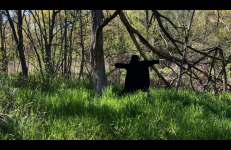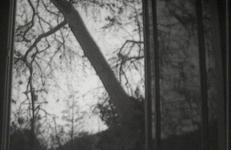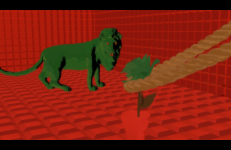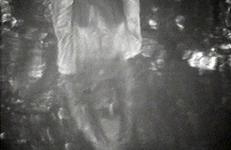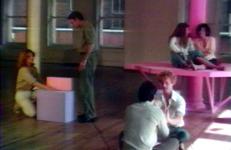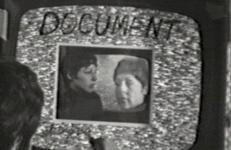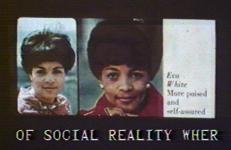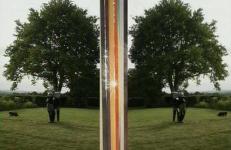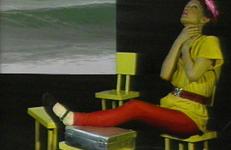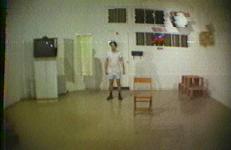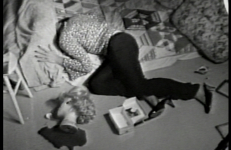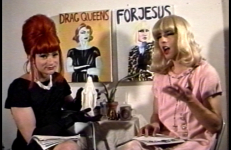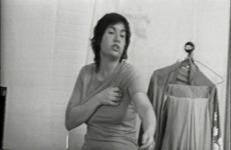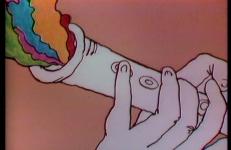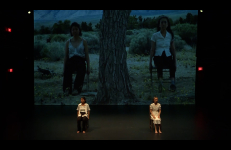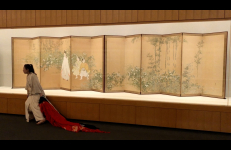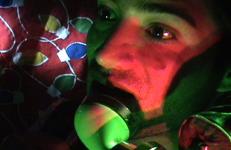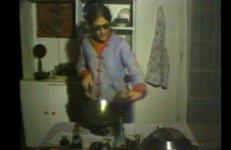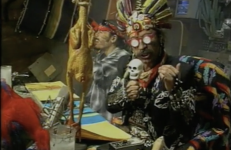As a "Post-Mexican” performance artist operating out of the US for over 20 years, one of my conceptual obsessions has been to constantly reposition myself within the hegemonic maps. Whether this map is the Americas, the larger cartography of art, or my personal biography, one of my jobs has been to move around, cross dangerous borders, disappear and reappear somewhere else, and in the process create "imaginary cartographies” capable of containing the complexities of my multiple and ever-changing identities, voices, communities and performative bodies.
Performance
Eiko Otake, with her collaborator Merian Soto, visited a friend Bonnie Brooks in her country house and had a long walk in the forest. There was a small island occupied by three deers. They later returned to it and the deer were gone so Eiko danced in that place she named Deer Island.
1933. Berlin. The last year of the Wiemar Republic. Through the lense of her personal "home movies", Leni Riefenstahl records a day in her life with a young Eva Braun.
Die Neue Frau is the third film in the The Surface Tension Trilogy, a three-part short film trilogy looking at queer artists living in Berlin during the 1920s. Shot on hand-processed 16mm film.
This structurally simple video, shot through Benglis's apartment window, contains a, "distinct disjuncture between the visual and aural components of the work. The viewer, initially presented with a contemplative view of nature, is frequently distracted by the chatter of a radio. As the camera zooms in and out, it establishes a dichotomy: indoors and outdoors, the man-made and the natural.
Distracted Blueberry follows a performance art band through a series of poetic encounters. Masculine tropes are undone to form a relationship between male sexuality and the human death drive. The body, violence and humour are positioned in the larger context of nothingness and somethingness, bridging a tension between externalized anxieties and the terrors of nature. Evocative of inner emotional states, strange landscapes exist as reflections of our shared dreams and nightmares.
Viewer discretion advised
Jonas uses reflections on a lake as a mirror to displace reality, creating a disruption and the illusion of presence.
“Disturbances begins with a Symbolist-like image of two women, dressed in white, seen only as reflections in water.… Throughout the tape the water fills the monitor, creating layers of images. The reflections on the surface of the water are superimposed on the activities that take place underneath the surface.”
The performers are seated around a pink octagonal table on pink, violet, and silver cinder blocks. One performer (Robert Stearns) stands up, recites the credits for the piece, and then says, “Do you believe in water? Robert Stearns.” He claps and turns to the next performer who asks the same question and gives his name. Next the players split up into pairs and attempt to relate to each other—playing tug-of-war, making love, arguing over who has the most integrity, and fighting for possession of the props.
To be a man, to be a hero, to be a wife: these conflicting voices inhabit the body of a documentary filmmaker as he re-enacts the climax of a Western morality play, 3:10 to Yuma.
This title is also available on Donigan Cumming: Controlled Disturbance and Donigan Cumming Videoworks: Volume 3.
With Benglis standing in front of a photograph of herself, which is then affixed to a monitor bearing her image, the notion of "original" is complicated—making the viewer acutely aware of the layers of self-images and layers of "self" that are simultaneously presented. Like Martha Rosler's Vital Statistics of a Citizen, Simply Obtained, Benglis presents the viewer with a "document" of questionable veracity. It is a document attesting not to the "real" Benglis, but to the impossibility of discerning one real identity.
Rosler calls Domination and the Everyday, with its fragmented sounds, images, and crawling text, an artist-mother's This Is Your Life. Throughout this work, we hear—but do not see—a mother and small child at dinner and bedtime while a radio airs an interview with a gallerist about Californian art of the 1960s. The soundtrack moves into overdrive with feedback, a passing train, barking dogs, and a bedtime story. The visuals, all still images, are drawn from television, movies, advertising, and the family album.
Four dummies, two cats, and a portal to bliss inside their attempts at symmetry. A hairball, and a mess of twigs, whose love has died and who are sad.
Based on Robert Heinlein’s 1941 story “Universe,” Double Lunar Dogs presents a vision of post-apocalyptic survival aboard a “spacecraft,” travelling aimlessly through the universe, whose passengers have forgotten the purpose of their mission. As a metaphor for the nature and purpose of memory, the two main characters (portrayed by Jonas and Spalding Gray) play games with images of their past; but their efforts to restore their collective memories are futile, and they are reprimanded by the “Authority” for their attempts to recapture their past on a now-destroyed planet Earth.
Like all of Smith’s videotapes, Down in the Rec Room is based on a performance that finds Mike once again all dressed up with nowhere to go. Smith mimes along with a children’s “let’s play make believe” record, and then repeats the action—this time disco dancing along with Donny and Marie on the TV set. Down in the Rec Room continues Smith’s critique of American fantasy culture by depicting the sorry life of the average guy.
In this video, Brenda Sexual, Glennda Orgasm, and friends act out a drag queen murder mystery that takes place on their talk show. Later, they attend the Queer Fashion Army Invasion, a sit in of openly queer public fashion performance outside the Fashion Institute of Technology in Manhattan. Then, the pair arrives at a video store to discuss queer undertones of Hollywood films, like Grease, Rocky II, and Yentil.
In this episode of The Brenda and Glennda Show, Brenda and Glennda create a satire of 1990's infomercials. The video includes interviews and performances by Vaginal Davis, Bruce LaBruce, and Chris Teen.
An episode of The Brenda and Glennda Show, hosted by Brenda Sexual and Glennda Orgasm.
In this episode of The Brenda and Glennda Show, Brenda and Glennda comically debate changing the name of their show to Drag Queens for Jesus, in order to convert all the secular homosexuals to Christianity. They discuss topics like abortion and censorship from a drag queen perspective, exploring the hypocrisy and inherent bias of Christian ideals. Later, Brenda gets her nipple pierced in homage to Sandy Daley's Robert Having His Nipple Pierced (1971).
A reverse striptease, non-stop comedic monologue about shopping for clothes, while eating corn nuts. Dressing Up was inspired by the artist’s mother’s penchant for bargain hunting. Mogul produced Dressing Up as a student in the feminist art program at the California Institute of the Arts in 1973.
Commissioned for the Ocularis curated Free to Be…You and Me Invitational compilation, which premiered at Brooklyn’s Galapagos Art Space and also screened at Chicago Filmmakers, where Mercedes Landazuri and I performed a banjo and synth rendition of “It’s Alright to Cry” (the song that followed Dudley Pippin on the compilation).
Illness, treatment, recovery, conversation. This experimental short presents stories of illness and disfunction, bringing together but also separating two performers, their stories, their bodies.
“Duet confronts illness with a caress; it takes us on a journey with two different people with two distinct conditions that present obstacles to very specific senses. A film that makes us address the way that we feel, hear, see, taste, and speak.” —Lynne Sachs
The Duet Project: Distance is Malleable is a mutable and evolving series of experiments in collaboration. Negotiating differences of race, time, culture, ethnicity, religion and gender, the artists seek to maximize the potentials of their encounters.
Eiko's grandfather Chikuha Otake (1878–1936) was a praised figure in traditional Japanese painting. But his anti-mainstream sentiments were shunned by the field authorities. His reputation was severely damaged by his failed run for the House of Representatives. Filmed in 2018, at the Philadelphia Museum of Art and the Suiboku Museum in Toyama, Japan, Eiko's edit combines videos of Chikuha's paintings and Eiko's performance with quotes from his essays and Eiko's musings.
Special thank you to David Brick, Ryohei Endo, Hiroyuku Horikawa, Feliece Fischer, and John Killacky.
Cherokee-American artist Jimmie Durham has worked in performance since the mid-’60s. In the ‘70s, he immersed himself in activism, working for Native American rights as part of the American Indian Movement. In the ‘80s, his focus returned to producing art in multiple forms—performance, poetry, and mixed-media visual works—that consider Native American identity and critique American domestic colonialism. He has also published numerous critical essays.
This European flavored melodrama depicts a fictional country of refined manners and debased desires that explode into chaos, sending its prodigal son into the pit of 20th Century technology. That technology externalizes his hidden beauty just as he tries to hide the heritage of horror which was the curse of his lineage. That curse now threatens the already damned.
Rosler uses the format of a cooking demonstration (as in Semiotics of the Kitchen) to address cultural transaction--the meeting of Eastern and Western cultures. Reading directly from a West Bend Electric Wok instruction booklet, Rosler wryly comments upon the Oriental mystique conjured by the West Bend manufacturers, a mystique evoked and then "improved" upon through Western technology--i.e. non-stick surfaces and electric power.
Interrupting the nightly news in an act of guerrilla television, Gómez-Peña returns to the persona of a Chicano-Aztec veejay—"The Mexican who talks back, the illegal Mexican performance artist with state of the art technology"—to elaborate the complications of American identity. This post-NAFTA Cyber Aztec pirate commandeers the television signal from his underground "Vato bunker", where virtual reality meets Aztec ritual. Gómez-Peña embodies the doubly radical Chicano performance artist, delivering radical ideas through a radical form of entertainment.





